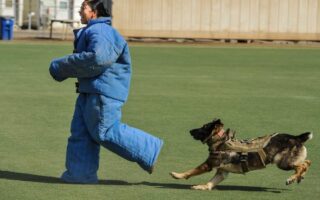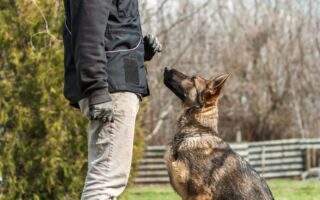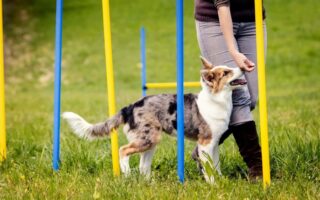In a world bustling with distractions—from the lure of a squirrel darting across the path to the enticing smell of a nearby food cart—walking your dog can sometimes feel more like a tug-of-war than a leisurely stroll. Enter the art of loose leash walking: a harmonious approach that transforms everyday outings into enjoyable adventures for both canine and human. This practice not only fosters a stronger bond between you and your pup but also cultivates a calmer walking experience, free from the chaos of constant pulling and jerking. In this article, we will explore the principles of loose leash walking, practical techniques for training, and the benefits it brings to you and your furry companion. Whether you’re a seasoned dog owner or a newcomer navigating the leash, this guide promises to enhance your daily walks and enrich your bond with your beloved pet.
Table of Contents
- Understanding the Foundations of Loose Leash Walking
- Essential Techniques for Effective Training Sessions
- Common Challenges and How to Overcome Them
- The Benefits of Mastering Loose Leash Walking for You and Your Dog
- Q&A
- To Wrap It Up
Understanding the Foundations of Loose Leash Walking
Loose leash walking is more than just a technique; it’s an essential skill that fosters a positive relationship between you and your furry companion. The roots of this practice lie in understanding your dog’s natural instincts and behaviors. By utilizing positive reinforcement—rewarding your dog for staying by your side—you create an environment where your pet feels motivated to walk calmly. This method is effective because dogs naturally desire to please their owners. When they associate walking beside you with rewards, they are more likely to repeat that behavior, leading to pleasurable outings for both of you. Some foundational tips to begin with include:
- Choose the right leash: A well-fitted harness or flat collar can prevent discomfort and improve control.
- Start in a distraction-free zone: Begin training in a quiet area to help your dog focus on you.
- Use treats and praise liberally: Acknowledge and reinforce desired behaviors promptly.
Moreover, understanding your dog’s body language is crucial when practicing loose leash walking. Dogs communicate through their posture and movements, and being attuned to these signals allows for smoother training sessions. Recognizing when your dog is anxious, excited, or distracted helps you adjust your approach accordingly. Incorporate regular short training sessions, gradually increasing distractions and distance as your dog’s skills develop. The following table outlines useful body language cues to watch for:
| Dog Signal | Meaning |
|---|---|
| Tail wagging | Excitement or happiness |
| Frozen stance | Unease or fear |
| Paw lifting | Curiosity or readiness to move |
Essential Techniques for Effective Training Sessions
Engaging your dog during training sessions for loose leash walking can be achieved through various dynamic techniques. Begin by creating a positive environment, where distractions are minimal, and both you and your dog feel comfortable. Utilize reward-based training to reinforce good behavior. When your dog walks beside you without pulling on the leash, promptly reward them with a treat or verbal praise. This establishes a clear connection between their actions and positive reinforcement, which will motivate them to repeat the desired behavior. Make sure to keep the training sessions short but consistent, as dogs generally respond better to concentrated bursts of activity rather than prolonged sessions.
Incorporating different walking patterns, such as sudden turns or changes in pace, can also be effective in keeping your dog’s attention. This technique encourages them to focus on you rather than the environment. Additionally, consider using a marker word or clicker to signal to your dog when they are walking correctly, which can further clarify your expectations. Monitor their progress and adjust the training based on their response. Here’s a quick reference table to summarize key points:
| Technique | Description |
|---|---|
| Reward-based Training | Use treats or praise for good behavior |
| Changing Walking Patterns | Incorporate turns and pace changes to maintain interest |
| Marker Word/Clicker | Signal correct walking behavior for clarity |
Common Challenges and How to Overcome Them
Walking your dog on a loose leash may seem straightforward, but it often comes with a set of challenges that can test even the most patient pet owners. One common issue is pulling, which can be especially frustrating and can lead to sore arms or strained relationships between you and your furry companion. To tackle this, consider using positive reinforcement techniques. Reward your dog with treats or praise whenever they walk beside you without pulling. Consistency is key, so always be ready to reward the right behavior, and gradually increase the duration of the loose leash walking sessions. Additionally, invest in a quality harness or collar that discourages pulling without causing harm.
Another frequent obstacle many face is distractions during walks, such as other dogs, squirrels, or even interesting smells. These can easily divert your dog’s attention away from you and lead to erratic behavior. To overcome this, start training in a low-distraction environment before gradually introducing busier settings. You might find it helpful to create a training schedule that includes exercises focusing on attention and impulse control. For example, use the “Look at Me” command by rewarding your dog when they maintain eye contact, effectively teaching them to prioritize your direction over outside distractions.
| Technique | Description |
|---|---|
| Positive Reinforcement | Rewarding with treats or praise for desired behavior. |
| Quality Harness | Using a harness designed to prevent pulling while ensuring comfort. |
| Look at Me Command | Training your dog to give you their attention in distracting environments. |
The Benefits of Mastering Loose Leash Walking for You and Your Dog
Mastering loose leash walking transforms your daily outings into a pleasant experience for both you and your furry friend. This training fosters a strong bond between you and your dog, promoting communication and understanding. With a dog that walks calmly by your side, you can enjoy your strolls without the worry of pulling or tugging, allowing you to focus on the world around you. The benefits extend beyond the immediate control; you’ll notice a decrease in stress levels during walks, resulting in a more enjoyable atmosphere as you both engage with your surroundings. Furthermore, it encourages your dog to remain relaxed and attentive, enhancing their overall behavior.
Here are several advantages to perfecting loose leash walking:
- Increased Safety: A well-trained dog is less likely to dart into traffic or cause accidents.
- Better Focus: Your dog will learn to pay attention to you, improving overall obedience.
- Stronger Bond: Training together strengthens your relationship through shared activities.
- Enhanced Social Interaction: A dog that walks calmly is more approachable for other dogs and people.
Implementing this technique can lead to significant changes in your dog’s behavior. Consider tracking your progress with a simple table:
| Week | Progress |
|---|---|
| 1 | Introduction of loose leash concept (short walks) |
| 2 | Incorporating rewards (positive reinforcement) |
| 3 | Practicing in various environments |
| 4 | Consistency achieved, enjoyable walks! |
By committing to the practice of loose leash walking, you pave the way for a harmonious partnership, rich in learning and fun.
Q&A
Q&A on Loose Leash Walking: A Guide for Dog Owners
Q1: What exactly is loose leash walking?
A1: Loose leash walking is a dog training technique where the dog walks alongside its owner without pulling or straining against the leash. It promotes a calm and relaxed atmosphere for both the dog and its owner, allowing for enjoyable strolls together. Essentially, the leash remains slack, signifying a cooperative bond between human and canine.
Q2: Why is loose leash walking important?
A2: Loose leash walking enhances the walking experience for both dogs and their owners. It fosters better communication and strengthens the relationship between them. Additionally, this technique ensures safety in crowded or busy environments, minimizing the risk of accidents and providing your dog with mental stimulation during walks.
Q3: How do I start teaching my dog loose leash walking?
A3: Begin in a familiar, low-distraction environment. Use treats to reward your dog for walking next to you with a loose leash. Start with short sessions to maintain focus, gradually increasing the duration as your dog learns. Use cues such as “let’s go” to signal movement and consider partnering it with stop-and-start exercises to reinforce the desired behavior.
Q4: What if my dog keeps pulling on the leash?
A4: If your dog pulls, stop walking immediately. This teaches them that pulling leads to a halt in progress. Wait for them to return to your side and loosen the leash, then reward them for staying close. Consistency is key; they will learn that a relaxed walk means rewards and progress, while pulling equals stops.
Q5: Are there specific tools that can help with loose leash walking?
A5: Yes! Consider using a front-clip harness which redirects pulling behavior by positioning the dog’s body toward you. Leashes with a padded handle can also provide comfort during training. However, tools should complement training, not substitute it—focus on reinforcing commands and behaviors.
Q6: What are some common mistakes to avoid while training loose leash walking?
A6: A few common pitfalls include using harsh corrections, which can harm the trust between you and your dog, or allowing them to reinforce pulling by moving forward when they tug. Additionally, inconsistent training can confuse your dog. Stay patient and persistent, as mastering loose leash walking takes time and practice.
Q7: How can loose leash walking benefit my dog’s behavior overall?
A7: Practicing loose leash walking can have a ripple effect on your dog’s overall behavior. It builds impulse control, reduces anxiety during walks, and decreases unwanted behaviors like lunging at other dogs or people. A well-trained dog tends to be happier and more confident, leading to a more relaxed home environment.
Q8: When should I seek professional help for loose leash walking?
A8: If you find yourself struggling to make progress or if your dog displays fear or aggressive behaviors on leashes, consulting a professional trainer or behaviorist may be beneficial. They can offer personalized guidance and strategies tailored to your dog’s specific needs.
Q9: Is loose leash walking suitable for all dog breeds?
A9: Yes! Loose leash walking can be taught to dogs of all sizes and breeds. However, each dog is unique; some may require more time and patience than others. Understanding your dog’s personality and energy levels can help tailor the training approach for success.
Q10: How can I make loose leash walking more enjoyable for my dog?
A10: Incorporate play into your walks by allowing short breaks for sniffing or exploring. You can also introduce fun activities like training sessions, or obedience challenges throughout the walk. Keeping the experience fun and engaging reinforces the positive aspects of loose leash walking for both you and your furry friend!
To Wrap It Up
As we wrap up our journey into the world of loose leash walking, it becomes clear that this practice is about more than just maintaining control over our furry companions; it’s about fostering a deeper connection and understanding between us and our dogs. Through patience, consistency, and positive reinforcement, we can transform our walks into enjoyable adventures—where exploration and companionship go hand in paw.
Remember, each step taken together on a loose leash is a testament to the bond you share, allowing you to rediscover not just the streets of your neighborhood, but the joy of moving through life side by side. So, grab that leash, step outside, and embrace the freedom of joyful strolling. With a little dedication and the right approach, you’ll find that both you and your dog are ready to embark on countless new adventures, one loose leash at a time. Happy walking!


